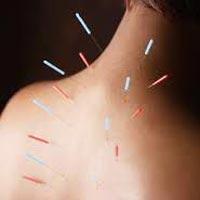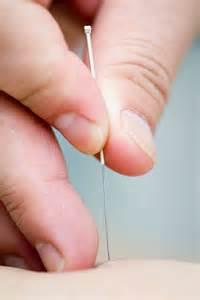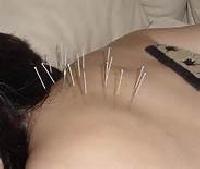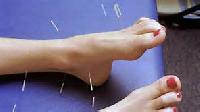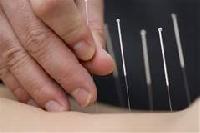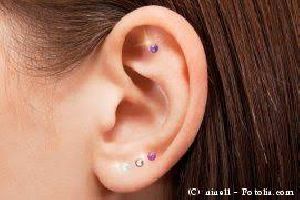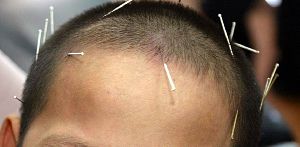Thane, Maharashtra
Acupuncture Treatment
|
|
|
|
Nowadays lot of awareness has been devoloped about Acupuncture, a drugless therapy with no side effects. It is widely accepted by the society and used extensively for the variety of medical purposes ranging from prevention to treatment of various diseases.The main emphasis of acupunture is prevention and harmony, same like our oriental siences Aayurveda and Yog say.
According to Chinese philosohy, the body contains two opposite forces Yin (prakriti) and Yang (purusha).When these forces are in balance, the body is at ease. The constant flow of energy, called "Qi" flows like rivers along the pathways or meridians throughout the body which keeps Yin and Yang balanced. Sometimes this flow of energy blocked and disease occurs.
Approximately 2000 different acupuncture points lie along the body‘s meridians. The idea behind acupuncture is that stimulating these points with acupuncture needles relieves obstructions in the flow of energy which enables body to heal itself.
Now, the World Health Organization (WHO) has approved Acupuncture as a mode of treatment. In India also, The Central Health Ministry had issued order vide their no. R.14015/25/96-U&H(R) (Pt) dated 25/11/2003.
Acupuncture has been a major part of primary healthcare in China for the last 5,000 years. It is used extensively for a variety of medical purposes ranging from the prevention and treatment of disease, for relieving pain and anesthetizing patients for surgery. As in many oriental medicine practices, the emphasis of acupuncture is on prevention. In traditional Chinese medicine, the highest form of acupuncture was given to have a long and healthy life.
Acupuncture is an art, which was found from ancient time in India, China, Japan and Sri Lanka. Then it was developed further in China. Now it is proved as science and it is commonly accepted as a mode of treatment in western countries.
The World Health Organization (WHO) has approved Acupuncture as the mode of treatment. WHO also studied the effects of acupuncture and concluded the list of disorders, which can be treated with Acupuncture.
In India also Acupuncture is accepted as a mode of therapy. The Central Health Ministry had issued order vide their No. R.14015/25/96-U&H(R)(Pt) dated 25/11/2003. General public also accepted acupuncture, as it is a drugless therapy having no side effects. It is best known for the control of pain. It is also commonly observed that after trying variety of treatments in many cases, the patients turn to acupuncture and they are either cured or their comfort level is increased.
How Acupuncture works?
The different theories exist as to how acupuncture works.
Eastern View
According to Chinese philosophy, the body contains two opposing forces: yin and yang. When these forces are in balance, the body is healthy. Energy, called "Qi", flows like rivers along pathways, or meridians, throughout the body. This constant flow of energy keeps the yin and yang balanced. However, the flow of energy can sometimes be blocked, like water getting stuck behind a dam. A disruption in the flow of energy can lead to illness.
Approximately 2,000 different acupuncture points lie along the body's meridians. The idea behind acupuncture is that stimulating these points with acupuncture needles relieves obstructions in the flow of energy, enabling the body to heal.
Western view
In the Western view, acupuncture likely works by stimulating the central nervous system (the brain and spinal cord) to release chemicals called neurotransmitters and hormones. These chemicals dull pain, boost the immune system and regulate various body functions.
Modern View
From the modern perspective, diseases and injuries are resolved by a complex set of responses; the responses are coordinated by several signaling systems. The signaling systems mainly involve peptides and other small biochemicals that are released at one site, travel to other sites, interact with cells, and stimulate various biologically programmed responses. Microorganisms, metabolic failures, changes in DNA structure or signaling, or breakdown of the immune system, cause the diseases. Some of these disorders are resolved by the cellular functions that are designed for healing, while others become chronic diseases because the pathological factors involved have either defeated the body's normalizing mechanisms or because something else has weakened the body's responses to the point that they are ineffective. For example, poor nutrition, unhealthy habits, and high stress can weaken the responses to disease.
Modern studies have revealed that acupuncture stimulates one or more of the signaling systems, which can, under certain circumstances, increase the rate of healing response. This may be sufficient to cure a disease, or it might alleviate some symptoms.
The primary signaling system affected by acupuncture is the nervous system, which not only transmits signals along the nerves that comprise it, but also emits a variety of biochemicals that influence other cells of the body. The nervous system, with over 30 peptides involved in transmitting signals, is connected to the hormonal system via the adrenal gland, and it makes connections to every cell and system of the body.
Additional Information
| Shelf Life | 2 Years |
Contact Us
Swasthya Holistic Healing Center
5th Floor, Indira Tower, Opp Prakash Hardware, Shrikhande Wadi, Manpada Road, Thane, Maharashtra - 421201, India
Mobile : +91-9987506831, +91-7710961351
E-mail : acuyogtherapy@gmail.com



